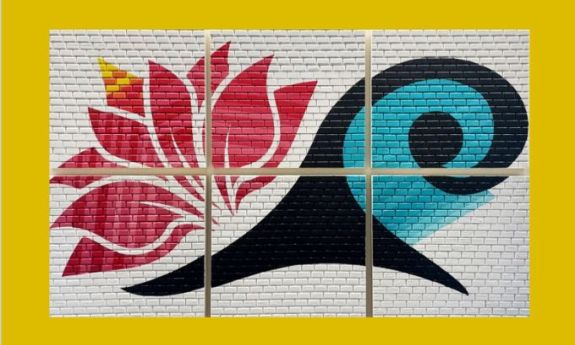AAPI Mural Travels to the Library
Here’s the significance of the mural, which was completed at the hospital last year

Rebecca Lee, a developer with Duke Health Technology Solutions and co-founder of the Duke AAPI Affinity Group, said the mural depicts the affinity group logo: a juxtaposition of a lotus flower and the Polynesian wave tattoo symbol.
The significance of the lotus flower
“The lotus flower is significant in many East and South Asian cultures as a symbol of rebirth and resilience since the flower blooms out of a muddy environment. Polynesian tattoos are a rite of passage for many Pacific Island cultures, and the affinity group chose the wave symbol specifically because water connects all the islands together,” Lee told Duke Today.
“We combined the images to reflect that our group encompasses all Americans, especially those of Asian and Pacific Islander descent,” she added.
Completion of the mural turned into a community project: Members of the AAPI affinity group helped paint the different wood blocks, which were arranged in a design created by Johnson.
Johnson, who works with the university’s Office of Information Technology as a media producer and animator, told Duke Today that he developed the wood block medium about five years ago “right before the Covid pandemic.
“I was looking for a way to combine my graphic design, photography and woodworking hobbies into one mixed-media form of artistic expression,” he said.
A way to build community
Lee said the idea for the AAPI mural came about after she saw a mural that Johnson created in 2022 for DiversifyIT, “a staff-led community that works toward awareness and support for all identities in IT at Duke,” according to a Duke University School of Medicine website. This mural is still on exhibit at the PowerHouse in West Village in downtown Durham.
Lee co-founded the AAPI Affinity Group in 2021 with Duke School of Medicine Dr. Suephy Chen, chair of the Dermatology Department, to provide a safe space for AAPI colleagues to gather and build community. Initially, in-person gatherings were limited due to the pandemic.
AAPI History at Duke
The strong growth of the AAPI community at Duke has been decades in the making. In fact, Asians and Asian Americans have been part of this college since the early days of when Trinity College was in Randolph County. In 1880, Charles Soong, a Shanghai native, became Trinity’s first international student. He stayed a year before transferring to Vanderbilt College, later becoming a prominent international businessman.
Others followed: At least 16 identifiable international students of Asian descent who attended Trinity for any amount of time between 1881-1924, according to the library archives.
Not all were men. One female Japanese student Yaskuko Ueno was part of the first class to graduate from Duke University in 1925.
A century later, Asians and Asian Americans at Duke accounted for nearly 30 percent of first-year students who enrolled in the fall of last year, the school’s second largest ethnic group at the university.
During their second AAPI Heritage Month celebration in 2023, AAPI affinity group leaders organized a painting event, inviting members and their families to apply their artistic talents to the creation of the mural. A second painting event was held at the Duke TechExpo, providing DiversifyIT members the opportunity to participate.
“Similar events were also held at each of the three Duke hospitals, allowing team members to connect and foster a sense of community," Lee said.
Dr. Paul Evangelista, who chairs the AAPI Affinity Group’s professional development, said the response to the mural has been incredibly moving.
“We’ve seen patients, staff, and visitors pause to engage with the stories it tells—many expressing how meaningful it is to see AAPI experiences and identities represented so vividly in a healthcare setting,” a “It has opened up conversations, sparked reflection, and created moments of connection that might not have happened otherwise.”
Evangelista credited Duke University Libraries’ Visual Diversity Committee with getting the mural on display at Perkins. It will be on exhibit at Perkins Library until May 8, 2027. He added that there aren’t any plans yet to move it elsewhere, but he’s grateful it found a current home on West Campus.
“What’s been most meaningful to me is seeing how the mural invites people to pause and reflect,” Evangelista said. “When something like this creates space for connection and belonging, especially around AAPI experiences, it feels like a small but real step toward building the kind of community Duke aspires to be.”
Any departments interested in hosting the traveling mural project should contact aapi@duke.edu.